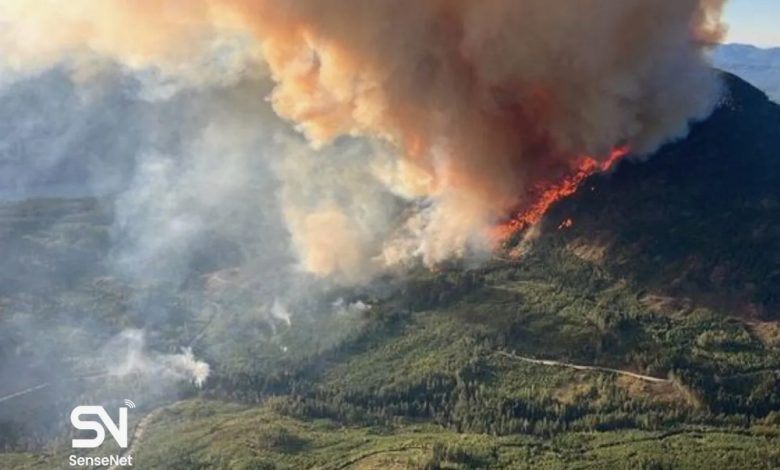
Wildfires are getting faster and costlier. Detection is still slow. In many places, it relies on lookouts, patrols, old cameras, and 911 calls. By the time a plume is obvious, wind and terrain can turn a spark into a fast-moving fire. False alarms waste crews’ time, real alerts often arrive late. Data lives in radios, emails, and siloed apps, so verification drags.
SenseNet thinks it can change that timeline. The company has raised a $14 million Series A led by Stormbreaker, with Thin Line Capital, Fusion Fund, Plaza Ventures, FOLD36 Capital, and B Current Impact Investment joining. The round lifts total funding to more than $15 million. The money will fund U.S. expansion with new offices and installations.
The pitch is straightforward: use sensors, cameras, satellites, and weather data, stitched together by AI, to catch fires before they’re visible and guide the response in real time.
The new detection stack
SenseNet’s system runs on three layers:
- Gas sensors that look for fire-specific gases in the smoldering phase. The company says these units are built for harsh sites, can run up to 10 years without a battery change, and don’t require cellular or satellite links. Catching gases early can flag risk hours before smoke or flame.
- AI cameras with 360° coverage and up to 50 miles of range that watch for anomalies and auto-zoom to verify a plume.
- Satellite and weather feeds that deliver wide-area context.
All signals feed a single incident-management platform. The software fuses inputs, sends high-confidence alerts, maps perimeters and hot spots, and forecasts spread up to seven days. The goal is one screen for dispatch and command, fewer false alarms, and more time to act.
“We’re building the most comprehensive wildfire intelligence network in the world,” says Hamed Noori, co-founder and CEO. “With wildfires intensifying across the globe, our mission is clear: detect and help stop fires before they become catastrophic.”
Early coverage and customers
SenseNet says its network already protects 130 million acres across Canada, the U.S., Indonesia, Brazil, and Chile, among other regions, with 100+ partnerships in place.
In Vernon, British Columbia, the system has moved beyond pilots. “Their technology provides our responders with real-time visual coverage of much of the city’s wildland interface,” says David Lind, Fire Chief for the City of Vernon. “Beyond early detection and notification, we’re using it to enhance situational awareness, anticipate operational needs, and model potential fire growth during incidents.”
Investors see the same mix of prevention and operational value. “SenseNet has developed a best-in-class solution to protect communities from the devastating impact of wildfires. Their combination of advanced sensing, simulation, and mitigation technologies represents a step-change in how we safeguard people and infrastructure,” said Shane Wall, Partner at Fusion Fund, former CTO of HP and White House Technology Advisor.
Wade Oosterman, Partner at Stormbreaker, frames it as an economics story too: “Our high conviction in SenseNet stems from the company’s ability to reduce the enormous cost of fighting wildfires for governments and for insurers the prohibitive costs of recovery to a fraction of that through an intelligent investment in prevention. I can’t imagine many people would not prefer that to dealing with the devastating aftermath of the destruction wildfires can bring.”
Aaron Fyke, Founder and Managing Partner at Thin Line Capital, adds: “Wildfires are getting worse, putting property and lives at risk. We look to back companies using data analytics to address problems like this, and were drawn to SenseNet’s approach and the success they’ve already had reducing risk for customers.”
Why this matters
The market is crowded with cameras and satellite services, but detection still breaks down in three places:
- Speed. Traditional systems cue after a visible plume. Smoldering fires can go unseen in heavy fuels or complex terrain.
- Signal quality. Operators drown in alerts. False positives slow real response.
- Fragmented tools. Weather, fuel models, camera feeds, and satellite passes live in separate systems. Stitching them together takes time crews don’t have during wind events.
SenseNet’s bet is that multi-modal sensing + one workflow fixes those gaps: catch gases early, verify with cameras, widen the picture with satellites, and push a unified alert with a forecast. It’s prevention and incident command in the same loop.
The business case
Wildfire losses hit communities, utilities, insurers, and governments. A reliable early-warning layer can cut response time, shrink fire footprints, and lower suppression and recovery costs. For customers, the ROI comes from avoided spread, better staffing decisions, and fewer false rollouts.
With the Series A, SenseNet plans to scale U.S. deployments, adding offices and field teams, and deepen integrations with public-safety and utility workflows. Expect more emphasis on operational forecasting, automated perimeter mapping, and tools that feed directly into dispatch, evacuation planning, and utility shutoff protocols.
Government agencies, utilities, and landowners can learn more at http://sensenet.co/.




